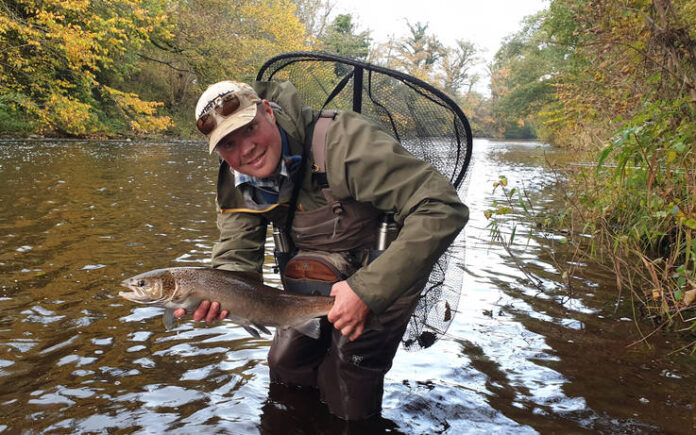BY ANDREW WILKINSON
THE sky darkened and rain arrived – right on cue.
After a very dry summer, October was marked by welcome wet weather, and the last month of the salmon fishing season was a good one.
The Tees and the Wear rose in early autumn, and frequent spells of rain ensured that neither river dropped back to its summer level. Instead the river lifted then dropped a little at regular intervals, resulting in salmon and sea trout entering and leaving the pools on a steady basis.
In these conditions the key to success is spending time on the water, so that you are there when the fish decide to take a fly or lure – or in my case a worm.
I don’t use bait for migratory fish – though some anglers catch a lot of fish on prawns. However, I arrived on the Wear one morning when the river was high and the water carrying a lot of colour.
That tends to happen in the first flood for weeks, for the banks are dry and soil washes from the banks, with the suspended particles reducing visibility to a couple of inches.
With fish unable to see fly or lure, the angler can either sit it out and wait for the river to clear, or resort to a smelly bait. This particular angling club allows any method, so I scrounged a worm from one of the lads already fishing.
We caught eels and brown trout, then after striking into a bite, the rod arched over and after a short battle, a 3lb sea trout splashed onto the bank. And there are those who believe that sea trout don’t feed once they leave the sea.
It was hardly a conventional way to catch a sea trout but it was the first fish of a good few weeks, in which salmon and sea trout fell to fly on a regular basis.
Salmon were caught on the Tees as far upstream as High Force.
Some anglers had a bumper last month, among them Teesdale’s Olly Shepherd, of Fly Fishing Yorkshire. He’s a great enthusiast and expert guide, whose tuition has helped many anglers catch their first salmon on the fly.
This autumn he helped ten anglers to the unforgettable experience of catching their first salmon – while finding the time to catch a good number of his own.
I caught up with him on the banks of the River Wear shortly after he had released a superb weighty fish.
He caught another as we chatted, and though it weighed no more than five or six pounds, he is more encouraged for the future by small fish than big ones.
Salmon that return to the river after just one winter at sea are known as grilse. Some are as small as a couple of pounds, and they weigh no more than six or seven pounds.
A high percentage of the fish caught on the Wear this year were grilse, which bodes well for the future as it shows that fish have spawned successfully over the last few years.
It is believed that young fish spend a couple of years in the river before heading to sea to pile on weight, then return to the river to spawn. While some head upstream after a few months at sea, others stay in salt water for a few years.
The size of fish when they return gives a rough guide to how many years they have been at sea.
When we take up angling we all want to catch our first fish. Then we want to catch lots of fish. Then many tend to focus on catching the biggest fish they can.
But all caring anglers look to the future. And good spawning seasons, and the survival of as many parr and adult salmon as possible is what matters most.
Which is why a healthy grilse, carefully returned to the river, can be as welcome a catch as a personal best fish.
Salmon and sea trout face many dangers before and after leaving the sea, and anglers are on their side, for these days fewer and fewer anglers keep fish for the table.
Footage has been shared on social media this year of dolphins working as a team to round up sea trout in the North Sea, while seals and cormorants are equally ruthless predators, and their numbers have increased significantly in recent years.
But there can be a happy ending for the fish. One of the officials of an angling syndicate circulated a video of salmon digging their redds for spawning, in the gravel bed on a small tributary of the upper reaches of the Wear.
The footage was shot in early November, and gave anglers a perfect lift going into the close season.
The more fish that negotiate all the hazards to reach their goal, the better the future for the species.
Credit: Source link































